Contents
of the winter 2007 Northants News
|
|
RHS
Garden Wisley |
Picture from Roland
Tebbenham |
|
Roland
visited the RHS gardens at Wisley to see the newly built
Conservatory. Wow! Now that’s a greenhouse and a half! It has 3000
square metres of floor, cost £7.8M and the new lake in front has
5.9 million litres of water which is used for irrigation. The Ed has
this vision of a gardener filling his watering can from it. Perhaps
not…
Though
a bit sparse at the moment there is some imaginative planting and
this landscape of succulents should repay a visit especially in a
few years time.

|

Top; The
new Conservatory at Wisley seen across the new lake. Below: Succulents
planted in the Conservatory.

|
|
|
And now
for something completely different... |
|
PAIGNTON A
10 ft-tall polystyrene cactus, that was rescued from a skip has been
identified as a prop from the opening credits of Monty Python’s Flying
Circus (Simon de Bruxelles writes). The cactus was featured in the sketch
Scott of the Sahara, which was filmed at Paignton, Devon. Carol Cleveland,
a co-star, lost her bikini top when it got snagged on the cactus. It is to
be sold to raise money for a children’s charity and is expected to fetch
up to £1,000 at Bonhams. |

|
This article was snipped by
Roland for our interest and the picture found on the internet. It raises several
fundamental taxonomic questions. Of course we would need to know the species but
the Sahara seems an unlikely habitat for a Cereus like cactus. Even in 1970.
Perhaps it is a Euphorbia? The specimen looks pretty moribund and I seem to
remember a Monty Python sketch that went, ‘This cactus is dead…’. Or am I
getting confused? There are also supporting questions about Carol Cleveland’s
bra and its loss. Has it been found? We await a profound article in Bradleya.
Thanks to the Times and the
Torquay Herald Express
|
|
The 2007
Oxford Show |
Roland Tebbenham |
Roland was able
to visit the Oxford Show in September, lucky devil. The Ed would have been there
too, but there is just so much to do and so little time. (And some of the
so-much-to-do is work!) Anyway Roland took us some photos of plants that took
his fancy - there are some great growers in Oxford.
Oxford
Branch Autumn Show was a well organised event with some 650 plants on the bench.
There was a lot to see including a Haworthia Society show, book sales by
Keith Larkin, plant sales by Croston cacti and the Oxford Branch.
Unfortunately I could not stay for the lecture by John Lavranos, but my
half-day was busy. Since the
entrants had come from far and wide, there were many old friends to chat to with
a coffee.
Here
are just a few plants that grabbed my attention; though they caused me to
question my own growing methods!
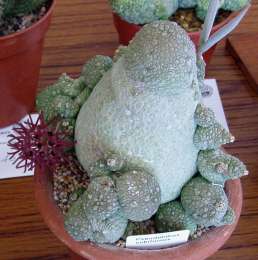 |
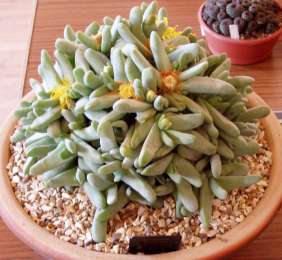 |
 |
|
Gillian
Evison won a first in the Stapelia Group (up to 13cm) with this superb Pseudolithos
cubiformis which was in flower and fruit.
|
Glottiphyllum
oligocarpum Another of Gillian Evison’s superbly grown plants.
This shows the lovely surface farina conferring a grey colour.
Plenty of flowers are evident, but the clump is not overblown with
too much nitrogen. Well
deserving of the Award of Merit.
|
Echinocactus
(Homalocephala)
texensis Stirling Baker’s entry winning the Echinocactus group
class. A very clean plant,
with strong gleaming, colourful spines, very flat and not overfed.
|
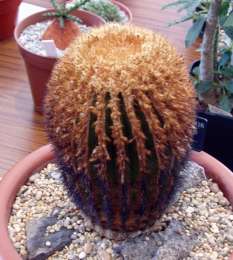 |
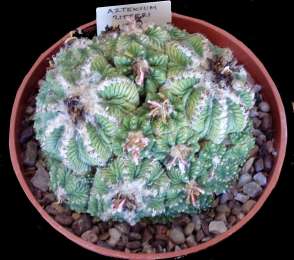 |
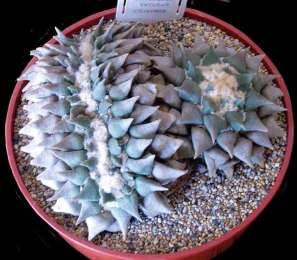 |
|
Uebelmannia
flavispina Gillian Evison’s second prize winner in class-26.
Well grown, clean, very woolly in the apex.
Plants in this genus always show woodiness in the lower stem as
they age, but this is not dominant in this fine example.
|
Aztekium
ritteri Though not the
largest plant of this species at the show I think this clump was
excellent. Alice Vanden Bon
has grown this really well – all the heads are active with many flowers
and none of the corky lower stem is visible, as is evident on my own
plant. This rightly earned
first prize in the 13cm class for two Cacti partnered by a fine
Turbinicarpus.
|
Ariocarpus
retusus Another Stirling
Baker plant winning class-56 for Cristate or Monstrose plants.
As many readers know I am fond of cristate plants, still a bit of
an enigma as to the cause. Should we call this semi-cristate since one head is normal?
Not to worry – it is healthy, well grown and nicely presented as
such a fine specimen should be.
|
Do
keep an eye out for these events combining a branch show with a special interest
group display, show or lecture. They
draw interesting people and excellent plants from around the country and the
plant and book sales add spice to the overall recipe!
Roland
| Thanks
to Woolies
A friend who insists on
being anonymous received this jolly Mammillaria disguised as a Father
Christmas as a present last year. What good taste and thank you Woolworths.
Or do you disagree? Chez Wray, please note that any son who buys the Ed
one of these will be disinherited. It is not the Father Christmas you
understand, it is that Mammillaria. |

|











